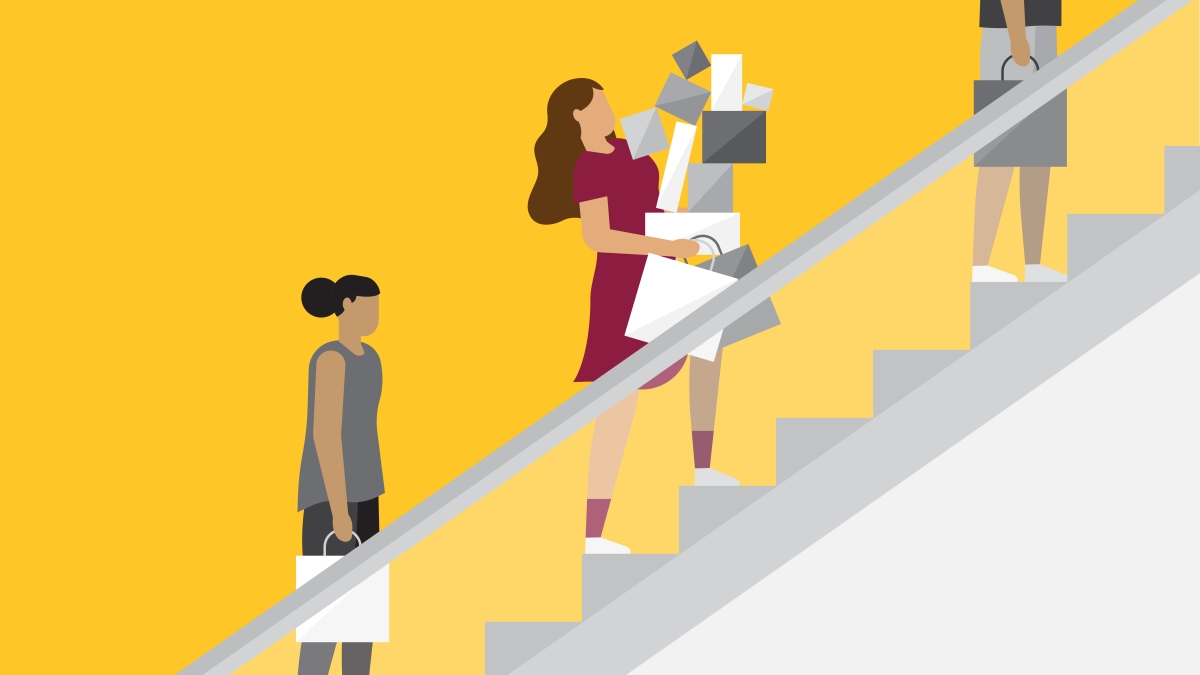So maybe you’re not as far along in your career as you thought you’d be, and your paycheck isn’t great. So you buy a cool new SUV to park in your driveway.
Will that tell the world that you’re successful? Or will it be an expensive reminder that you’re falling short of your goals?
Two Arizona State University marketing professors have researched that question in a new paper titled “Compensatory Routes to Object Attachment,” which they were invited to write for a special edition of the journal Current Opinion in Psychology.
Naomi Mandel, professor of marketing, and Monika Lisjak, an assistant professor of marketing, are both experts in compensatory consumption – when people buy or display items as a way to cope with “self-discrepancy,” which is the difference between who we are and who we want to be.
“I’ve looked at social exclusion,” Mandel said. “When people feel they’re excluded from social groups, they’re more interested in consuming nostalgic products because it gives them a sense of continuity and is a reminder of family and friends and the times they felt included.”
Lisjak was inspired by her observations of people who were displaying luxury items but turned out to not be very wealthy.
“I was intrigued why they spent so much money to showcase this status and it was clear it was an important signal they were trying to send to others,” she said.
But then what happens after the person buys the item? Do they become super-attached to it?
“It’s this idea that a person can have an emotional bond with an object, like a car, in much the same way they have a bond with a person,” Mandel said.
“Monika and I have been mainly focusing more on the mental process that happens when people make these choices, but there’s not a lot of research looking at what happens afterward – how people form these bonds with these objects they’ve chosen for this compensatory reason,” Mandel said.
Their paper was among the first to bridge that gap by reviewing existing research and suggesting a framework for more study.
Self-discrepancy can trigger different kinds of compensatory consumption. One is “fluid compensation,” which is when people who feel insufficient in one area try to boost their self-worth in a different area. For example, one study found that people who felt physically unattractive were more willing to buy intelligence-enhancing items, like language-learning CDs.
Mandel and Lisjak are currently running a cross-cultural study on Facebook.
“We think there’s a difference between Asian consumers and Americans, because Asians tend to be more holistic thinkers,” Mandel said.
“It’s easier for them if they feel self-discrepancy to shift to another domain to compensate. If they feel incompetent at work because they had some sort of setback, they can shift to fitness or something else that meets a goal in another domain.
“Americans tend to stick with the same domain when they feel threatened.”
Their new paper, done with doctoral student Qin Wang, proposes that the chances of bonding with a product depends on the type of compensation.
“We dug into the literature and were able to find some evidence in terms of ‘symbolic compensation.’ So if somebody feels left out of a social group, they can become attached to things like dolls or stuffed animals as a direct substitute,” Mandel said.
“Or they might become attached to a restaurant or bar, which researchers call ‘the third place,’ because they are attached to the people they see there, like the servers. They substitute one attachment for another.”
But symbolic compensation can also fail, Lisjak said. Her research found that people who buy products to signal their status can see it backfire because the product reminds them that they’re not as wealthy as others.
Another kind of consumption is escapism. Studies have shown that people are more likely to consume fatty foods when they recall losses by their favorite teams, which softens a self-discrepancy in sports identity. Items bought for this reason might inspire strong attachment, Mandel and Lisjak said, citing research on smartphones.
But the research is sparse and doesn’t address all the issues regarding why people buy products and whether they get attached to them, they wrote.
The overall goal is to help companies improve the way they market products.
“They want consumers to be attached to objects because it fosters loyalty,” Mandel said.
“Just showing that this phenomenon exists in the real world is something that there still needs to be research on and more applications for marketers.”
Lisjak said the researchers want to do field studies to measure the effects of framing products as a way to bolster a sense of self.
“We want to see whether that has consequences for the consumer in greater word of mouth or less price sensitivity, which are markers of people being attached to objects,” she said.
And how would marketers know if someone has an issue with self-discrepancy? Social media.
“Companies are constantly mining social media using key words. If you put on Instagram, ‘I’m hungry,’ just wait a few minutes and Pizza Hut shows you their ad. It’s already happening,” Lisjak said.
“If there are key words that tap into self-discrepancy, we can show them this approach.”
Top graphic by Alex Davis/ASU Now
More Science and technology

ASU-led space telescope is ready to fly
The Star Planet Activity Research CubeSat, or SPARCS, a small space telescope that will monitor the flares and sunspot activity of low-mass stars, has now passed its pre-shipment review by NASA.…

ASU at the heart of the state's revitalized microelectronics industry
A stronger local economy, more reliable technology, and a future where our computers and devices do the impossible: that’s the transformation ASU is driving through its microelectronics research…

Breakthrough copper alloy achieves unprecedented high-temperature performance
A team of researchers from Arizona State University, the U.S. Army Research Laboratory, Lehigh University and Louisiana State University has developed a groundbreaking high-temperature copper alloy…


